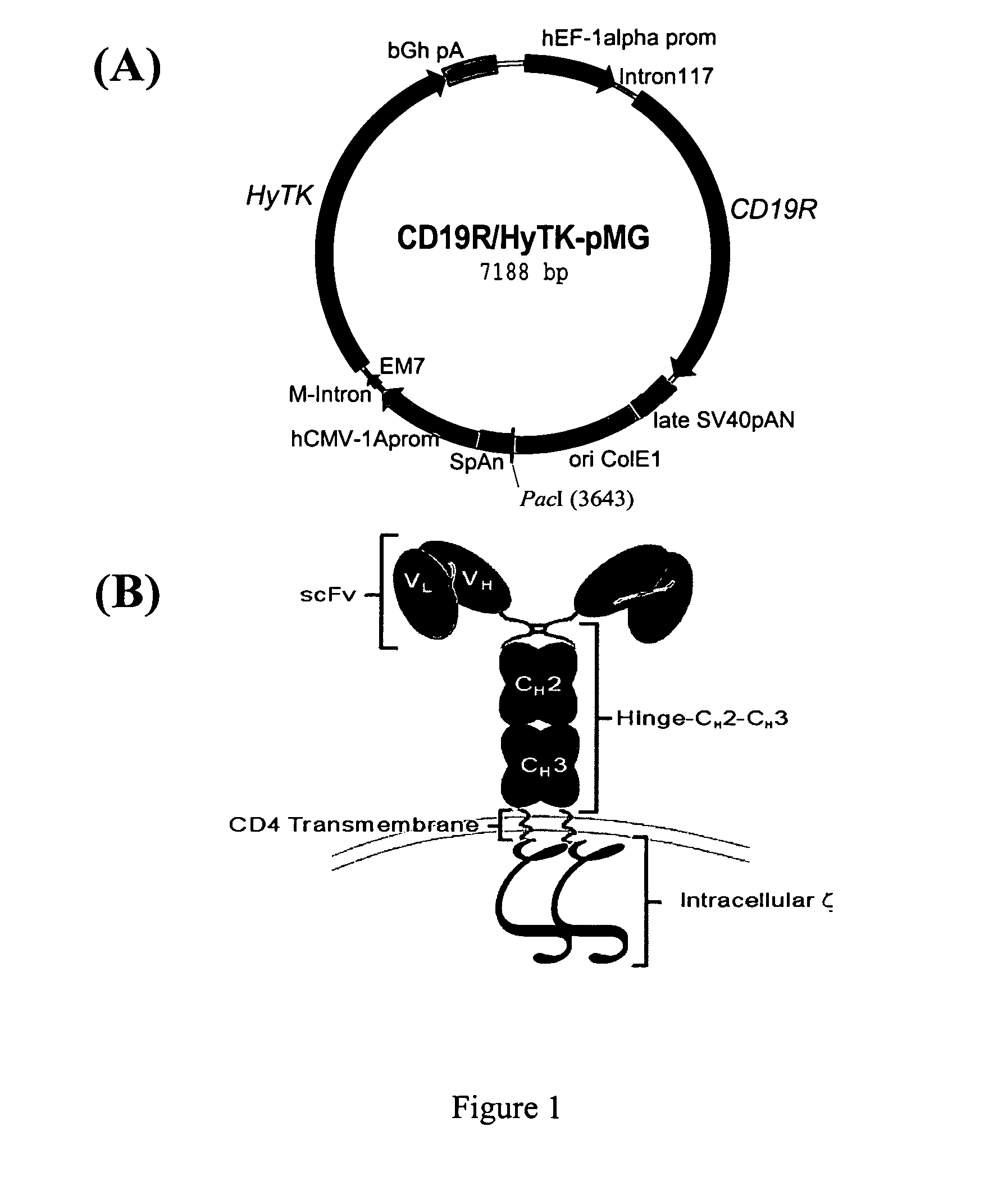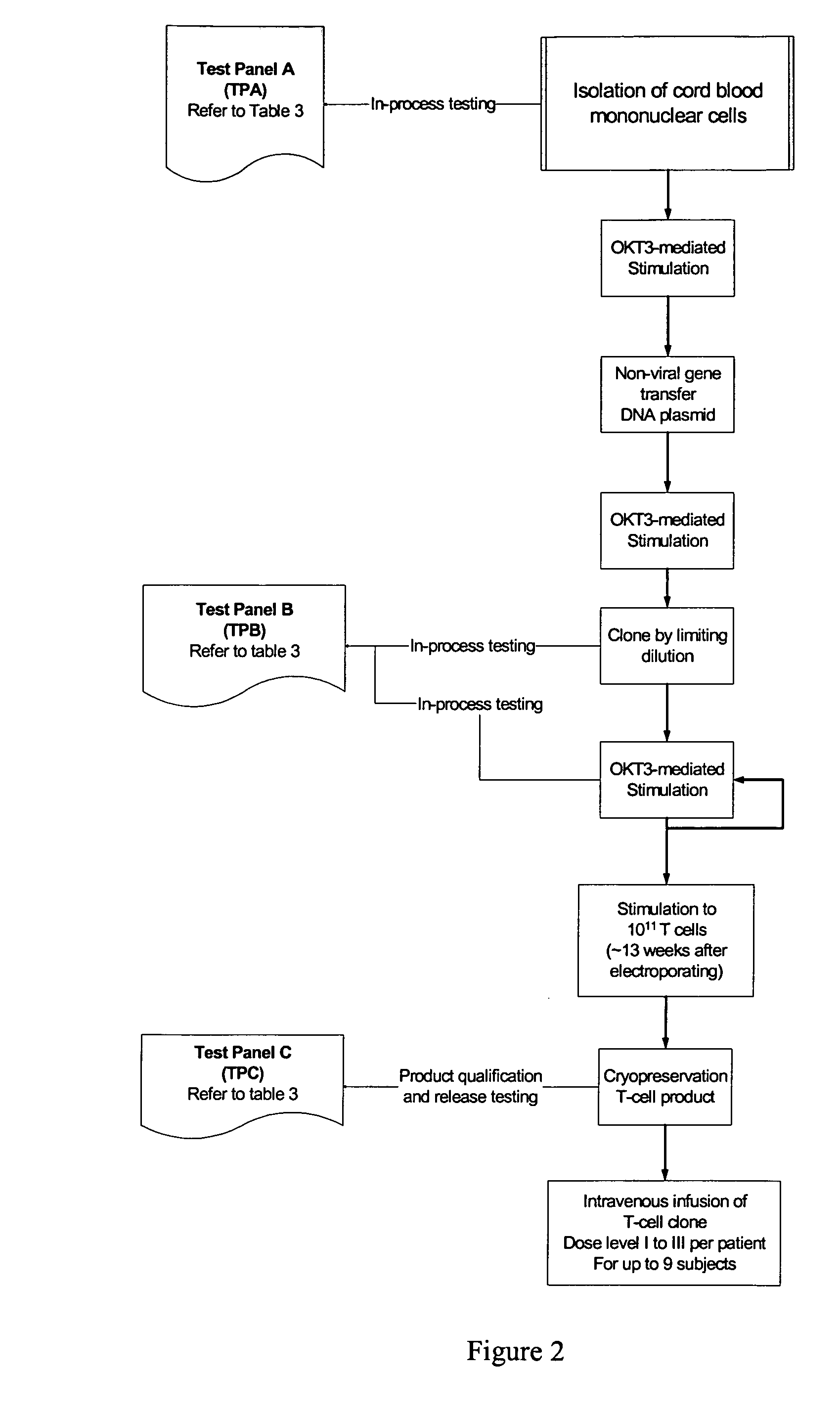Generation and application of universal T cells for B-ALL
a technology b-all, applied in the field of universal t cells, can solve the problems of high risk of relapse all, low complete response rate or high incidence of early relapse all, and achieve enhanced sirna effect, enhanced cell surface expression, and easy propagation
- Summary
- Abstract
- Description
- Claims
- Application Information
AI Technical Summary
Benefits of technology
Problems solved by technology
Method used
Image
Examples
example 1
Ex vivo Isolation and Expansion of Universal CD19-Specific Umbilical Cord Blood-Derived T Cells
[0048] The decision to use umbilical cord blood T cells (UCBT) as a platform for genetic modification and preparation of universal T cells is based on two properties intrinsic to UCBT: (i) The increased replicative potential of UCBT, as demonstrated by their greater telomere length, relative to T cells derived from peripheral blood (Li et al., 1994; Mackall et al., 1997) which translates into improved rates of ex vivo expansion and decreased probability for replication senescence in vivo after adoptive transfer and (ii) transplanted umbilical cord blood T cells have a higher tolerance to human leukocyte antigen (HLA) mismatch (Li et al., 1994; Mackall et al., 1997), which may reduce the potential for deleterious recognition of allo-antigens by the endogenous T cell receptor (TCR) expressed on the infused universal T cells. This is demonstrated by the low risk of graft-versus-host disease ...
example 2
Umbilical Cord Blood-Derived T Cells Can Be Rendered Specific for CD19
[0053] Following expansion, genetically modified cord blood-derived T cells can be harvested and evaluated by Western blot for expression of the chimeric immunoreceptor protein by probing with an anti-ζ mAb. Unmodified and modified T cells display a 21-kDa band consistent with wild-type CD3-ζ chain, but genetically modified T cells demonstrate a second band of ˜66-kDa consistent with the chimeric-ζ chain. Flow cytometry was used to show that the expanded genetically modified T cell clones were typically CD8+TCRαβ+Fc+. The ability of the genetically modified CD19R+ T cells to lyse CD19+ targets was assessed by a 4-hour chromium release assay (CRA). CD19-specific CTL were able to lyse human tumor lines independent of HLA molecules if the targets expressed CD19, but were unable to lyse targets that were CD19−. To show that the genetically modified CTL were activated for cytokine production, the CD19R+ T cells were s...
example 3
Manufacturing and Infusing CAR Re-Directed CTL into Oncology Patients
[0055] Investigators at City of Hope have established technologies for the ex vivo genetic modification, cloning, and large-scale expansion of human T-lymphocytes for FDA-authorized clinical trials. City of Hope's cGMP-compliant biologics manufacturing facility—The Center for Biomedicine and Genetics (CBG)—is a licensed built-to-suit 20,000 ft2 facility having three separate production areas for the manufacturing of viral vectors, recombinant protein and DNA, and ex vivo manipulated cell products. The CBG has established a FDA masterfile for plasmid DNA production (BB-MF#9778) and has recently been designated as a NGVL production site for clinical-grade plasmid DNA. A cell production suite within the CBG has been allocated for T cell manufacturing. These core technologies, and COH's infrastructure to support them, set the stage for the implementation of a series of rapidly deployed cellular immunotherapy clinical ...
PUM
 Login to View More
Login to View More Abstract
Description
Claims
Application Information
 Login to View More
Login to View More - R&D
- Intellectual Property
- Life Sciences
- Materials
- Tech Scout
- Unparalleled Data Quality
- Higher Quality Content
- 60% Fewer Hallucinations
Browse by: Latest US Patents, China's latest patents, Technical Efficacy Thesaurus, Application Domain, Technology Topic, Popular Technical Reports.
© 2025 PatSnap. All rights reserved.Legal|Privacy policy|Modern Slavery Act Transparency Statement|Sitemap|About US| Contact US: help@patsnap.com



